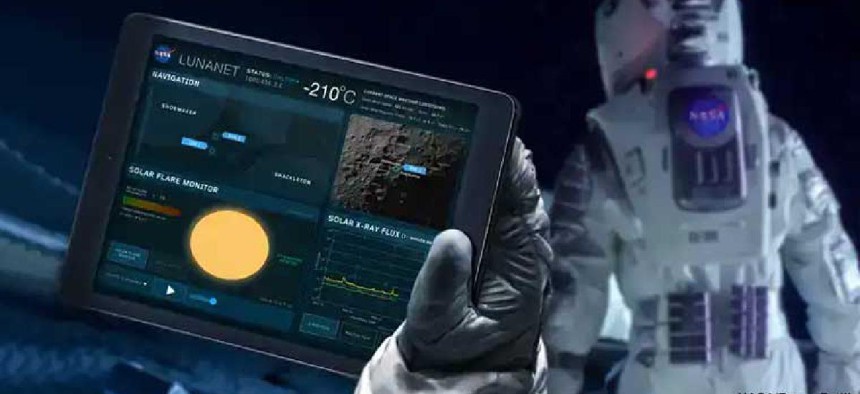LunaNet: NASA’s plan for internet on the Moon

To help establish a sustainable presence on the Moon, NASA is developing LunaNet, a relay communications and navigation architecture that will make it easier for devices to communicate with each other and with Earth.
To build a sustainable presence on the Moon by 2028, NASA is developing a relay communications and navigation architecture known as LunaNet to make it easier for lunar devices to communicate with each other and with Earth.
Envisioned much like the internet on Earth, LunaNet would enable communications among robotic landers, rovers, scientific devices and astronauts, and also allow them to transmit data back to Earth through Moon-orbiting relays, such as satellites, small sats or a Moon-orbiting space station. As long as each network node can relay data to its immediate neighbor, the LunaNet architecture can be assembled from a variety of infrastructure systems, independent of frequency band, type of spacecraft or provider, researchers at NASA Goddard Space Flight Center wrote in paper outlining their LunaNet vision.
Now NASA is asking for input. In an Oct. 2 request for information the space agency said it is seeking insights on relay services that could help transport data between a device or astronaut on the Moon and ground stations on Earth in situations where a direct link is not practical -- such as missions to the far side or poles of the Moon -- or when a relay link offers advantages, such as offloading traffic from Earth ground stations.
In the Apollo era, direct communication with Earth was only available from the near side of the Moon, and it was primarily used for transmitting telemetry data and low-resolution voice and video. LunaNet’s multi-hop relay network, on the other hand, could be accessed from anywhere on the Moon by surface or orbiting devices, provide direct access to Earth stations when required and supporting high-definition video for multiple users, NASA said in a presentation.
LunaNet is expected to include three categories of services:
- Networking services capable of moving data between nodes that adhere to confidentiality, integrity and availability requirements.
- Position, navigation and timing services for orientation and velocity determination, as well as time synchronization and dissemination. These services could be used for search and rescue, surface navigation and location tracking. “Navigation enables missions to determine position and velocity, plan trajectories, plan and execute maneuvers, and maintain time with accuracies appropriate to the meet mission requirements,” Goddard researchers said.
- Science services providing situational alerts and scientific measurements that could not only further research, but also support predictions of major solar eruptions that affect space weather and provide information about space radiation.
NASA anticipates many advantages to a relay navigation system. LunaNet would be critical for communications during deliveries of science payloads to the far side and polar regions, where direct communication with Earth ground stations will be impossible without a relay. For manned missions to the South Pole, “having a relay satellite in an appropriate orbit would allow for more flexibility in mission scheduling and landing site selection and would provide more options in contingency situations,” NASA said. It would also allow more video data to be relayed back to Earth.
NASA’s communications with rovers would be easier because LunaNet would be much closer to lunar vehicles, shortening the distance signals must travel and allowing the use of smaller, less powerful transmitters and receivers. Orbiting spacecraft, especially small satellites, also would benefit from precise timing and position information readily available from LunaNet.
To provide reliable service for the Artemis missions in 2024, LunaNet would have to be operational well in advance, so NASA wants the technology ready for operation no later than 2023.
More information is available here.
Meanwhile, NASA’s Space Technology Mission Directorate awarded Nokia $14.1 million to deploy the first LTE/4G communications system in space. The system could support lunar surface communications at greater distances, increased speeds and provide more reliability than current standards, NASA said in its announcement of the 2020 Tipping Point Selections.
Nokia is partnering with Intuitive Machines, a company selected by NASA to carry payloads to the lunar surface, to integrate this groundbreaking network into its lunar lander and deliver it to the Moon in late 2022. The network is designed to self-configure upon deployment and provide critical communication capabilities, including command and control functions, remote control of lunar rovers, real-time navigation and streaming of high-definition video, Nokia said in its announcement.
Nokia’s lunar network consists of an LTE base station with integrated evolved packet core functionalities, LTE user equipment, RF antennas and operations and maintenance control software. The small, lightweight, low-power solution has been designed to withstand the launch and lunar landing and to operate in the extreme conditions of space.
“Reliable, resilient and high-capacity communications networks will be key to supporting sustainable human presence on the lunar surface,” said Marcus Weldon, CTO at Nokia and president of Nokia Bell Labs. “By building the first high performance wireless network solution on the Moon, Nokia Bell Labs is once again planting the flag for pioneering innovation beyond the conventional limits.”






